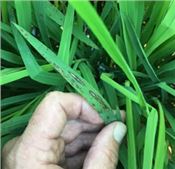Rice Blast Alert: First Confirmed Report On Jupiter At Green Ring Stage In Woodruff County

Fig. 1 and 2. Typical Diamond shaped
with ashy centers lesions of blast
and small non-sporulated lesions.
DR. YESHI WAMISHE
STUTTGART, ARK.
Most early planted rice in Arkansas is somewhere between green ring and panicle initiation and has started moving with the warm weather. We received a report of leaf blast on medium grain rice variety Jupiter which is at half inch internode elongation in Woodruff County (Figures 1 and 2). Last year, we also received our first report from the same county on June 20, 2016.
Although the blast fungus has different mechanisms of survival and spread, early blast disease in susceptible varieties can be well suppressed with deep flood management. Often when the first infected leaves dry and die back, leaf blast tends to “disappear” and may not be a problem. However, under favorable conditions if it turns severe, it can be devastating to leaves to the extent of killing the plants. The blast fungus in addition to leaves, infects leaf collars, panicle nodes, and panicles of the rice plant. Severe damage occurs when the fungus attacks the nodes. Spores from leaf blast disease serve as inoculum sources to infect susceptible rice of other fields in the area and also for the later stage neck and panicle blast diseases. Therefore, this is a cautioning to start and continue scouting your fields. It is difficult to predict the blast disease and, therefore, Scout! and Scout!
Tips on areas of the field to scout
• Field edges or spots short in water
• levees, shaded areas with tree lines (mostly on the east side) denser field spots due to overlapped seeding/or nitrogen fertilizer rates
• sandier soils that do not maintain permeant flood and low lying fields ∆
DR. YESHI WAMISHE: Extension Rice Pathologist, University of Arkansas